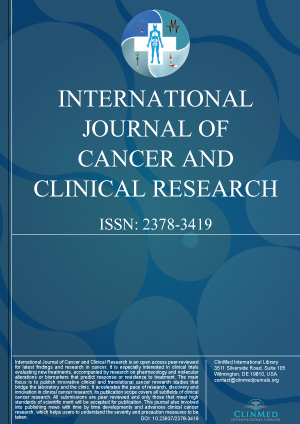Archive
Open Access DOI:10.23937/2378-3419/3/1/1045
Xiao Huang, Kazunori Kanehira, Fadi Habib and Bo Xu
Article Type: Case Report | First Published: February 19, 2016
Article Formats
- Full Article
Open Access DOI:10.23937/2378-3419/3/1/1044
Esther Dubrovsky, Farayan Jalalabi, Aysegul Sahin and Dalliah M Black
Article Type: Case Report | First Published: February 10, 2016
Article Formats
- Full Article
Open Access DOI:10.23937/2378-3419/3/1/1043
Developing Pathway Collection for Personalized Anti-cancer Therapy
Luminita Castillos and Anton Yuryev
Article Type: Research Article | First Published: February 01, 2016
Article Formats
- Full Article
Open Access DOI:10.23937/2378-3419/3/1/1042
Breast Cancer in Surgical Site: Unusual Presentation of an Ectopic Milk Line Malignancy
Zsolt Varga, Miklos Torok, Eva Sebo, Judit Toth and Dezso Toth
Article Type: Case Report | First Published: January 30, 2016
Article Formats
- Full Article
Open Access DOI:10.23937/2378-3419/3/1/1041
Shinichi Sekine, Takuya Nagata, Tomoyuki Okumura, Shunsuke Kawai, Katsuhisa Hirano, Takeshi Miwa, Makoto Moriyama, Hirofumi Kojima, Isaya Hashimoto, Kazuto Shibuya, Shozo Hojo, Isaku Yoshioka, Koshi Matsui, Shigeaki Sawada and Kazuhiro Tsukada
Article Type: Original Research | First Published: January 30, 2016
Article Formats
- Full Article
Open Access DOI:10.23937/2378-3419/3/1/1040
Iris Atzmon, Shai Linn, Elihu D Richter and Boris Portnov
Article Type: Research Article | First Published: January 30, 2016
Article Formats
- Full Article
Open Access DOI:10.23937/2378-3419/3/1/1039
Iris Atzmon, Boris Portnov, Shai Linn and Elihu D Richter
Article Type: Research Article | First Published: January 27, 2016
Article Formats
- Full Article
Open Access DOI:10.23937/2378-3419/3/1/1038
Yuko Takami, Susumu Eguchi, Masaki Tateishi, Tomoki Ryu, Kazuhiro Mikagi, Yoshiyuki Wada and Hideki Saitsu
Article Type: Original Article | First Published: January 11, 2016
Article Formats
- Full Article
Open Access DOI:10.23937/2378-3419/3/1/1037
Renty B. Franklin, Jing Zou, Yao Zheng, Michael J. Naslund, Leslie C. Costello
Article Type: Research Article | First Published: January 09, 2016
Article Formats
- Full Article

Volume 3
Issue 1
Issue 1
